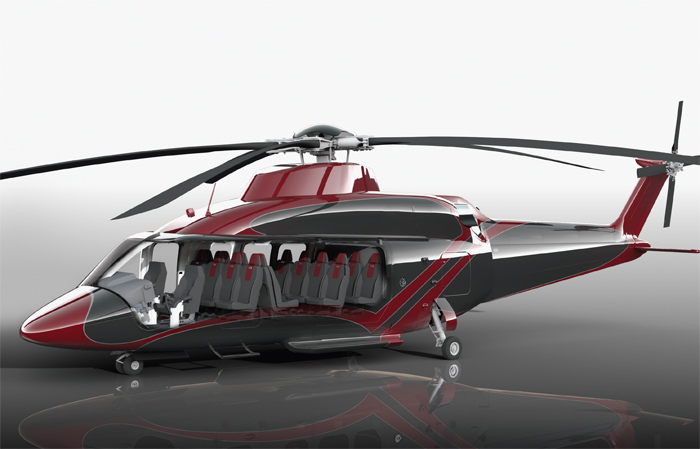

Bell Moves to “Game Change” With Its New Super-Medium 525 Relentless by Paul Pitts | The JetAv Blog.
At Dallas Heli-Expo 2012, Bell Helicopter announced the new Bell 525 Relentless “super medium” helicopter. This helicopter is Bell’s entry into the large helicopter market as the oil and gas customers require lift capabilities to go farther and deeper to find product to satisfy the growing need for energy.
The Bell 525 Relentless defines the new “super medium” product class – positioned at the upper end of the medium class and designed to offer best-in-class capabilities to customers. It features superior payload and range, cabin and cargo volumes and crew visibility. Capable of carrying up to 16 passengers, the Bell 525 Relentless is designed to support customers in various mission configurations including oil & gas, search & rescue, helicopter emergency medical services and VIP/corporate transport.


TECHNICAL SPECIFICATIONS
Speeds: +140 kts (+260 kph)
Range: +400 nm (+740 km)
Max Gross Weight: +18,000 lbs (+8,160 kg)
Useful Load: +4,000 lbs (+1,800 kg)
Standard Seating: 2 Flight Crew – 16 Passengers
Power Plant: 2 X GE CT7-2F1
Avionics: Garmin G5000H, 4×15-in. Touchscreen Displays
Flight Controls: BAE Systems Fly-By-Wire
This new Bell helicopter will feature a new state-of-the-art flight deck, called “ARC Horizon”. The new ARC Horizon flight deck will feature unparalleled crew situational awareness through the use of a fully integrated, glass flight deck coupled with an advanced fly-by-wire flight control system resulting in enhanced safety levels and mission capabilities.
The ARC Horizon will debut the Garmin G5000H integrated avionics suite. It features high resolution, wide aspect ratio primary flight displays (PFD) and multi-function displays (MFD). The system supports multiple display sizes and is scalable to support a large number of display and touchscreen controller configurations. The landscape oriented displays have multi-pane capability that allows multiple pages to be viewed side-by-side on any of the displays. Therefore, pilots can simultaneously view their primary flight display, maps, charts, checklists and system synoptics, HTAWS, TCAS, flight planning, weather or video input pages.

Fly-by-wire with flight control computers by BAE Systems provide the ability to operate demanding missions in austere environments safely and reliably with decreased pilot workload.
The new Bell 525 Relentless will be powered by the GE CT7-2F1. This latest version of the CT7 engine family is designed with an emphasis on low fuel consumption, low cost of operation and with other technical features to ensure aircraft meet the requirements of long range, high payload missions. The CT7-2F1 engine includes a state-of-the-art Full Authority Digital Engine Control (FADEC) plus advanced materials, primarily in the turbine section.
Bell’s program is aggressive in both technology leap and in getting the new ship to market and reports it is committed to both.
Premier Jet invites your feedback via the comment section below.

it will be funny for the pilot to have type convention training on this brand new helicopter with latest FBW control. How to get used to flying traditional then the other day on FBW, like 737-300 then A320e?
FBW
is interesting in many ways as you can program in any amount of stability for
any aircraft type. This is used currently in many types of UAVs (fixed wing and
rotorcraft) that are operated by non-pilot types. Keeping basic "stick and
rudder" skills will present an ever increasing challenge as we incorporate
more and more technology into our aircraft. The recent A340 accident is a good
example of a very experienced flight crew failing to do something very basic
(pitch forward to recover from a stall) in a technologically advanced aircraft.
Don't get me wrong, I am a fan of FBW and the advances it offers, but we must retain our basic piloting skills in the process.